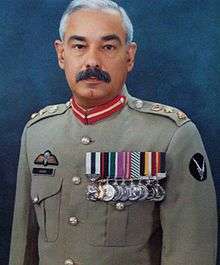Ahsan Malik
Ahsan Siddique Malik was a Pakistan Army officer who defended Kamalpur in the Indo-Pakistani War of 1971. He was a captain at the time, serving in the 31st Battalion, Baloch Regiment.
Ahsan Malik | |
|---|---|
 Ahsan Malik | |
| Born | 3 November 1948 |
| Nationality | Pakistani |
Defence of Kamalpur
Attacks against Pakistani border outposts in the north began in July. These were mounted by Mukti Bahini, mainly former members of East Pakistan's regular forces, but failed to make any impression. Further attacks on Kamalpur, a kilometre from the border, came on 22 October and 14 November, the latter being made by the Indian Army's 13th Battalion, Brigade of the Guards (of Kler's brigade), which established blocking positions to the south. Malik was cut off and his CO, Lt. Col. Sultan Ahmed tried to relieve him and the other two outposts (Naqshi and Baromari, to the east) without success. On 29 November Major Ayub of 31 Baloch tried to resupply Malik's tiny garrison but failed.
Kler tried to take Kamalpur on the run, using Mukti Bahini troops, and failed.[1] He then mounted an attack by the 1st Battalion, Maratha Light Infantry on the forty men and four 120mm mortars of 83 Mortar Battery and overran them, suffering one casualty. Kler then 'decided to lay siege to Kamalpur and break down its will to resist', according to Gen. Sukhwant Singh.[2] Getting wary because of casualties, successive failures and demoralisation among the attacking troops, he decided to starve out the garrison by a prolonged siege.[3]' Sukhwant Singh knew that there was no Pakistani artillery in this sector, only two troops of mortars, but states that Kler was '... further handicapped inasmuch as one of his battalions had just been reorganised from (a unit) raised initially for counterinsurgency with no support elements. In tackling a weak platoon post, another battalion brought out some weaknesses of leadership under fire. The battalion reached its objective with relatively few casualties. As expected, the enemy turned mortar fire on the objective. A mortar bomb landed on the trench occupied by four men close to the commanding officer (Colonel). He saw limbs fly and lost his nerve.'[4]
At about 0930 on 4 December, after withdrawing his troops from close siege, Kler 'hammered the post with seven sorties of MiG-21s firing rockets and cannon and this was repeated twice later in the day'.[5] Maj. Gen. Gurbux Singh (commander of the north region) himself entered affairs by sending Capt. Malik a note via a Mukti Bahini courier: '... whatever you decide to do we have every intention of eliminating Kamalpur post. It is to save you and our side casualties this message is being sent to you ...' He sent another note after a further air strike and this was met, as had been the other messages, by increased firing by Malik's men. But it could not go on, Malik received the order by radio to surrender, which he did at 1900 that day.
Sukhwant Singh stated, 'He had put up a courageous stand ... and surrendered after holding a brigade of besiegers for 21 days ... Sam Manekshaw sent a personal congratulatory message to Malik commending his defiant stand.' and wrote 'Militarily his performance was excellent'.[6][7]
Maj. Gen. Gurbux Singh decided to meet Malik personally but, while being driven towards Kamalpur by Kler, their jeep went over a mine and he was badly wounded.
When Capt. Malik's force was taken in, it was found that his company was nearly out of ammunition, barring a few hand grenades and a few bullets each. They were ready to fling themselves on the enemy with daggers and bayonets if it came to that, until they realised that the piece of territory they were defending was already a different country.
When he returned to Pakistan, he was decorated with a Sitara-e-Jurrat which is the third highest military award in Pakistan. Later on, Field Marshal Sam Manekshaw, Chief of Army Staff of the Indian Army at the time, acknowledged the bravery of Malik's men in a letter written to his Pakistani counterpart. He even wrote a personal letter to Malik.[8]
References
- Brian Cloughley (2002). A History of the Pakistan Army: Wars And Insurrections Second Edition With A New Chapter On The Kargil Issue. Lancer. p. 202. ISBN 978-81-7062-283-3. Retrieved 27 February 2012.
- Sukhwant Singh (19 July 2009). India's Wars Since Independence. Lancer Publishers. p. 162. ISBN 978-1-935501-13-8.
- Dr Nuran Nabi (27 August 2010). Bullets of '71: A Freedom Fighter's Story. AuthorHouse. pp. 356–. ISBN 978-1-4520-4378-4. Retrieved 27 February 2012.
- Economic and political weekly. Sameeksha Trust. 1977. p. 1325. Retrieved 27 February 2012.
- Lachhman Singh (1991). Victory in Bangladesh. Natraj Publishers. p. 151. Retrieved 27 February 2012.
- Sukhwant Singh (19 July 2009). India's Wars Since Independence. Lancer Publishers. p. 86. ISBN 978-1-935501-13-8.
- Times of India (1971). OFFICIAL 1971 WAR HISTORY (PDF). History Division, Ministry of Defence, Government of India. Archived from the original (PDF) on 9 June 2011. Retrieved 16 May 2009.
- "A lesson from the past". Hindustan Times. 14 April 2007. Retrieved 29 October 2019.
- Sukhwant Singh (1981). India's wars since Independence-The Liberation of Bangladesh, Vol. 1. Vikas Publishing House. ISBN 0-7069-1057-5.
- Brian Cloughley (2006). A history of the Pakistan Army – Wars and Insurrections Third Edition. Ameena Saiyid, Oxford University Press. ISBN 0-19-547334-5.